Here’s a 12-channel bidirectional logic level shifter with a 3.3V power regulator that I designed so I could easily interface 5V circuits with cool 3.3V widgets like the ADXL345 accelerometer, the NRF24L01+ wireless transceiver, and the Nokia 5110 84×48 LCD. For the one in the picture, I used round machine pin headers because I use it with hookup wire and those female headers are very easy to separate from 40-pin lengths.
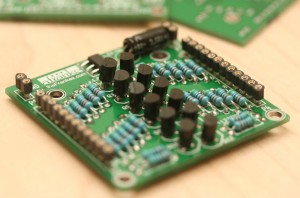
Up to twelve 5-15V logic signals can go into one side and come out as 3.3V signals on the other side, or the other way around (3.3V signals go in and can be read as 5-15V signals) in any combination. The regulator portion converts 5 to 15V DC into a steady 3.3V for up to 1 amp.
In this video, I show how it works translating from 7.5V to 3.3V. The video is from the A Hackable 12-Channel Bidirectional Logic Level Shifter/Translator post.
Why did I not just use a 74HC4050 or some other logic level translator? Because this is much cooler! It’s bidirectional, it has twelve independent channels, in includes a 3.3V regulator, it’s inexpensive, it’s good soldering practice, and it’s hackable. In the photo below, I’ve wired it up to specifically drive a 3.3V Nokia 5110 LCD. It uses only five of the 12 channels as logic level translators, channel two is wired directly to 3.3V for power, and channel 3 is wired directly to ground. The transistor on channel nine is turned so that the 5V signal controls the gate, which allows PWM control of the LED with full power from the regulator. I’ve also used a different resistor. (More photos below.) And why no resistor arrays? Because resistors are usually inexpensive and on hand, and resistor arrays would limit hackability.
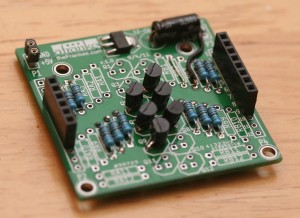
It’s essentially a AMS1117 3.3V regulator with capacitor at the top, and then an array of MOSFET pass transistor interfaces with n-channel 2N7000 MOSFETs. Each side is held high by a resistor 5.6k ohm resistor. If the 5V side is pulled low, the voltage from ground to source will be 2.7V because the diode becomes forward biased, and this turns on the transistor, pulling the 3.3V side low. If the 3.3V side is pulled low, the transistor also turns on with 3.3V, pulling the 5.5V side low.
It was designed using KiCAD (free), and PCBs were ordered through SeeedStudio’s Fusion PCB service. All the components are easily available online, at Digikey or on eBay. Here are the parts I used. The costs reflect per items costs for small bulk purchases (usually around 10-50 pieces) on eBay.
- 1 AMS1117 3.3V 1A Voltage Regulator – 28¢ (datasheet)
- 1 22uF electrolytic capacitor – 9¢
- 12 2N7000 n-channel MOSFET – 60¢ for 12 (datasheet)
- 24 5.6K ohm resistors – 43¢ for 24
- 2 12-pin female headers (I used round ones for the one in the picture, but you should use the standard square ones if you’re not just using jumper wires.) – 29¢ for one 40-pin header, then cut into smaller pieces.
- 2 2-pin female headers
- 1 custom PCB – $1.12
The total unit cost was $2.81, plus time and solder. I’ve decided to sell off the extras either as PCBs or as kits, so let me know if you’re interested by commenting below.
Here’s the schematic and a screenshot of the PCB design, as well as a larger version of the image above:

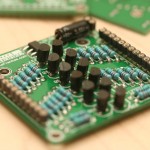
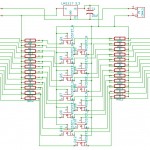
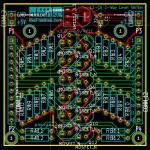
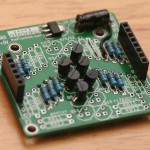
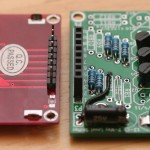
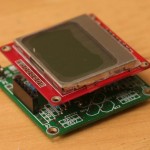

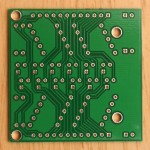
Hi;
very nice.
I would like some PCB’s.
Mick M
Okay — I’ll send you an email and let you know what I have left.
Do you have any of these kits left? I need 3 or 4 of them… if you have any…
Yes, I think I have three more. I’ll send you an email.
Hi, really nice pcb board u got there, and that’s exactly what i need to start on my project, so wondering if u still have some available it would be wonderful thx.
hello
where can a bought this pcb ?
Nice! What is the bandwidth of the shifter? Also, I was thinking that the 1117 could be replaced with an adjustable regulator, and this together with a pot would make the low side adjustable to any voltage below the high side (minus the drop-out).
Hi, I’m interested in your project of “level logic shifter”
I would like to know if PCB are still available?
How much, and how many pcb do you have?
Thinks
Do you still have the pcb and the resistors/1117/mosfet/caps?
Any chance you could publish an Eagle file with the PCB design? If so I could make some at home.